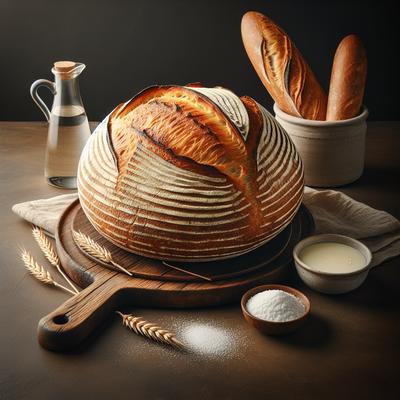Dairy-Free Classic Sourdough Bread
Experience the timeless allure of homemade sourdough with our Dairy-Free Classic Sourdough Bread recipe, a perfect choice for anyone seeking a traditional yet dairy-free option. This loaf boasts a chewy, golden crust and a tender crumb, achieved through a naturally leavened process using an active sourdough starter. With just four simple ingredients—flour, water, salt, and your starter—this recipe emphasizes old-world baking techniques like autolyse, stretch-and-fold, and cold-proofing to enhance flavor and texture. Ideal for beginners and seasoned bakers alike, this recipe delivers a tangy, artisan-quality bread without a hint of dairy. Perfect for sandwiches, toast, or simply enjoying with your favorite spreads, this sourdough staple is as versatile as it is delicious. Bake a loaf today and discover the joy of dairy-free, homemade sourdough bread!
Try SnapCalorie's FREE AI assisted nutrition tracking free in the App store or on Android.

Scan with your phone to download!

Ingredients
- 500 grams All-purpose flour
- 100 grams Active sourdough starter
- 350 milliliters Warm water
- 10 grams Salt
Directions
Step 1
In a large mixing bowl, combine the active sourdough starter and warm water. Stir until the starter dissolves completely.
Step 2
Add the all-purpose flour to the bowl and mix until a rough dough forms. Make sure all the flour is hydrated but do not overmix.
Step 3
Cover the bowl with a damp cloth or plastic wrap and let it rest for 30 minutes at room temperature. This is known as the autolyse phase.
Step 4
After 30 minutes, sprinkle the salt over the dough. Wet your hands slightly to prevent sticking and incorporate the salt into the dough by pinching and folding the dough onto itself.
Step 5
Once the salt is mixed in, perform a series of four stretch and fold techniques: Stretch one side of the dough up and fold it over itself, turn the bowl 90 degrees, and repeat. Do this four times in total. Cover the dough again.
Step 6
Let the dough ferment at room temperature for about 4-5 hours or until it has doubled in size, performing stretch and folds every 30 minutes for the first two hours.
Step 7
When the dough has finished fermenting, turn it onto a lightly floured surface. Pre-shape the dough into a ball by folding the edges into the center and flipping it over. Cover it with an inverted bowl or cloth and let it rest for 20 minutes.
Step 8
After resting, shape the dough into its final shape by gently stretching and rolling it into a ball or loaf shape, depending on your baking vessel.
Step 9
Prepare a proofing basket or bowl lined with a clean, floured kitchen towel. Place the dough seam-side up and cover it with the towel. Let it proof in the refrigerator for 12-18 hours for the best flavor and texture.
Step 10
Preheat the oven to 450°F (230°C) with a Dutch oven or a heavy baking dish inside to heat up.
Step 11
Once preheated, carefully remove the hot Dutch oven from the oven. Turn the dough out onto a piece of parchment paper and score the top with a sharp blade or knife.
Step 12
Transfer the dough with the parchment paper into the Dutch oven. Cover with the lid and bake for 20 minutes.
Step 13
After 20 minutes, remove the lid and continue to bake for an additional 20-25 minutes, until the bread is deep golden brown and sounds hollow when tapped on the bottom.
Step 14
Remove the bread from the oven and let it cool on a wire rack for at least 1 hour before slicing.
Nutrition Facts
| Serving size | (965.0g) |
|---|
| Amount per serving | % Daily Value* |
|---|---|
| Calories | 1870 |
| Total Fat 5.4g | 0% |
| Saturated Fat 0.9g | 0% |
| Cholesterol 0mg | 0% |
| Sodium 3942.3mg | 0% |
| Total Carbohydrate 391.6g | 0% |
| Dietary Fiber 14.6g | 0% |
| Total Sugars 1.1g | |
| Protein 52.6g | 0% |
| Vitamin D 0IU | 0% |
| Calcium 73mg | 0% |
| Iron 23.7mg | 0% |
| Potassium 556mg | 0% |
Source of Calories
